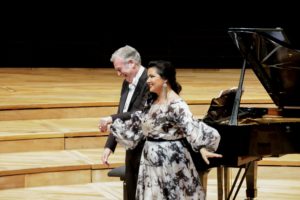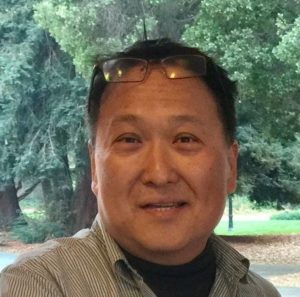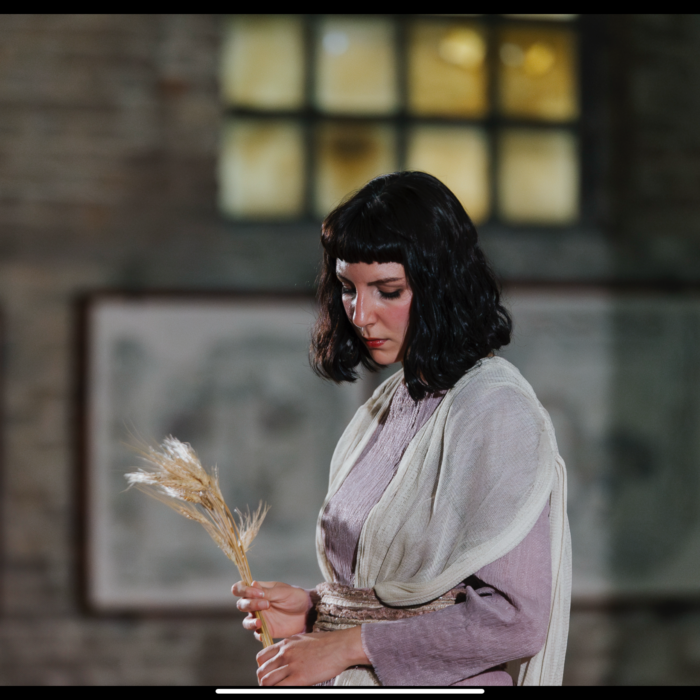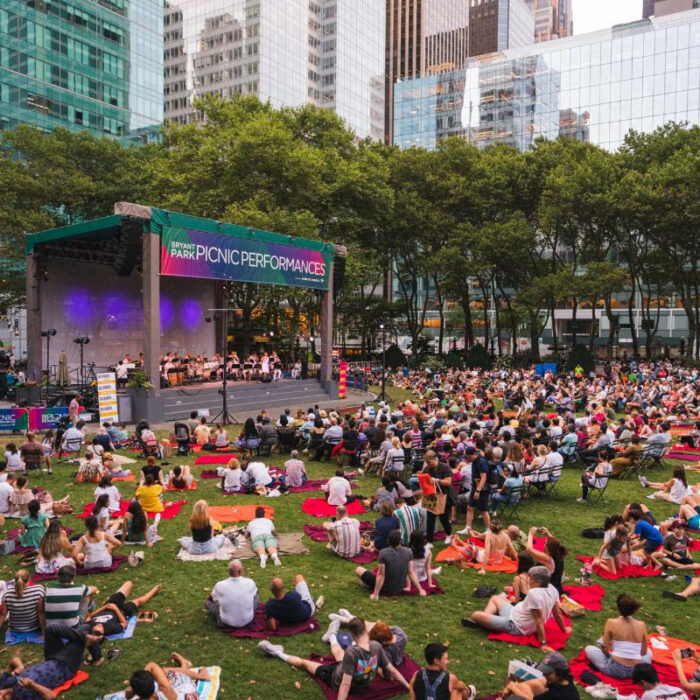
Philharmonie de Paris 2021-22 Review: Anna Netrebko – Day and Night
Following Controversy, Anna Netrebko Returns to the Stage in Paris
By Ching Chang(Credit: Yanny Tokyo)
It could have seemed like an ill-advised idea for some, but Russian soprano Anna Netrebko hit her stride on a remarkably successful return to the concert stage this week after a brief hiatus marked by political controversies.
Accompanied by pianist Malcolm Martineau at the great Pierre Boulez Auditorium at the Philharmonie in Paris under the auspices of the Les Grandes Voix series, the Russian soprano offered a wide-ranging and generous program proposed on themes titled as “Day and Night,” joined also by mezzo-soprano Elena Maximova and violinist Giovanni Andrea Zanon on a few of the selections. It was a decisive salvo and the first step in her attempt to resume her prominent international career.
The Lead Up
It goes without saying that war is a messy business, and it represents the ultimate breakdown of civility and order, which includes various social contracts. While the tribulations that impacted soprano Anna Netrebko’s professional life are insignificant compared to the victims in Ukraine who lost their homes, loved ones, and had their lives violently disrupted, the international Russian diva did find herself in a fine professional mess, after the longstanding perception of her closeness with Russian dictator Vladimir Putin came to the forefront again after the Russian invasion of Ukraine.
Before the current conflict, Netrebko had already faced protesters at the Met in the past for her association with the Russian leader, and the fact that she was photographed in 2014 in St. Petersburg with rebel separatists holding the Novorossian flag, while donating money to the Donetsk Opera House, was a particularly damning event. For Netrebko, a dual citizen of both Russia and Austria (an European Union nation, but non-NATO member constrained by its own constitution stipulating a position of neutrality towards external conflicts), perhaps even more of a misstep was her reluctance to condemn the Russian leader, once the current hostilities erupted.
Cancellations of high-profile productions soon followed, as she quickly became the diva non grata at the Metropolitan Opera in New York. Peter Gelb very publicly announced that she was being withdrawn from scheduled productions of “Turandot” and “Don Carlo” in the upcoming seasons and that she wouldn’t be returning to the house. This was the highest-profile termination at the Met since Joseph Volpe dismissed Kathleen Battle; or when Rudolf Bing fired Maria Callas more than six decades ago.
Facing further cancellations, Netrebko released a statement at the end of March, unequivocally condemning the war in Ukraine and distancing herself from Putin. It was perhaps too little too late for some theaters, and yet, for these statements she was now also being sanctioned in Russia having her concerts canceled and even called a “traitor” by political leaders.
For some, it was surprising then to see the diva back on stage in Paris so soon, and so prominently at the Philharmonie’s magnificent music complex at Parc de la Villette. Even among Netrebko supporters many would have advised her that, given the ongoing open combat in Ukraine, taking a longer hiatus could have been a wiser decision. But the Netrebko that emerges from this experience seems willing to show defiantly that she wants to be in charge of her destiny, for better or for worse.
Against the striking asymmetrical architecture of the Philharmonie’s Pierre Boulez grand auditorium, the tension and expectation kept building as the soprano was late coming onto the stage, and some impatient rhythmic clapping began to be heard in response.
The Recital
Netrebko finally emerged with pianist Malcolm Martineau and violinist Giovanni Andrea Zanon, and when the customary applause silenced with the musicians positioning themselves on stage, a loud pro-Ukrainian protest erupted from one of the hanging balconies of the auditorium. It was readily shouted down by others in the Parisian audience, and the rest of the evening proceeded without further disturbances.
The diva immediately proved to be in magnificent voice as she launched into the generous opening number, starting with the dramatic declamatory spoken recitation “Del sultano Amuratte…,” followed by an irresistible rendition of “Ecco, respiro appena” from Francisco Cilea’s “Adriana Lecouvreur.” These few months away from the public, it seemed, made her voice sound fresh and well rested, capable of spinning long and delicately shaped phrases of impeccable control, floating on her buttery, seamless, and luxuriant tone.
She then proceeded to offer a wide ranging program amplified and loosely based on the selections she had presented at Carnegie Hall and later in the Met Opera Stars concert, launched during the period of pandemic confinement. It weaved into a narrative arch art songs and assembled cycles of famous opera arias and duets, with songs by Richard Strauss, Debussy, Dvorak, and Russian composers. At first, this repertory list seemed like a confusing and unconnected catalog of random assortments, but ultimately Netrebko convincingly made it work.
In part, she did it by not confining herself to the standard practice of the recitalist occupying stationary the piano bay, but rather she added a degree of moderate theatrical effect by moving and using different places within the vast expanses of the stage at the Pierre Boulez Auditorium, a facility designed to accommodate very large orchestras. In Strauss’ “Morgen,” for instance, violinist Zanin played the gorgeous obbligato next to pianist Malcolm Martineau, while she sat on stage at one of the built in raised arched levels for the orchestra, as if she was in fact about to repose. It never felt out of place, and it was quite effective, so perhaps it could be a model that should receive more experimentation by other recitalists, especially as a means of introducing lieder to chamber music resistant opera audiences, and vice-versa.
Opera lovers were not disappointed with her offering of several spectacular prima donna arias, the diva’s bread and butter. In addition from the opening Cilea, she then offered Charpentier’s “Depuis le jour” from “Louise” with exquisite, soaring abandon; and rode through Leoncavallo’s “Stridono lassù” from “Pagliacci” with dramatic verismo muscularity. She also delivered the vocal sparkles, crowning Douglas Moore’s “The Silver Aria,” from “The Ballad of Baby Doe” with ravishing high notes. She then surprised many with a mezzo aria, “Printemps qui commence” from Saint-Saëns’ “Samson et Dalila.” After intermission, Netrebko was joined by the elegant and warm toned mezzo Elena Maximova, in a spirited and affirming rendition of the Pauline and Lisa’s duet from Tchaikovsky’s “Pikovaya Dama.” Maximova later joined the soprano again in the duet “Belle nuit, nuit d’amour” from Jacques Offenbach’s “Tales of Hoffmann.”
As much fun as the operatic show stoppers may be, it was truly in the Russian songs that Netrebko allowed the opera star to step back for a moment, so that the artistic person could emerge, not merely because of the idiomatic fluency, but rather the spiritual truth she was able to convey. She offered selections by Rimsky Korsakoff (“Zvonche zhavoronka pen’e”, Op. 43 n°1; “Redejet oblakov letuchaja grjada”, Op. 42 n°3) and Tchaikovsky (“Skazhi o chjom v teni vetvej”, Op. 57 n°1), where Malcolm Martineau supported the songstress with dignified charisma, showcasing his refined technical mastery and wonderful artistic instincts. Yet, it was in the Rachmaninov songs where she truly shone artistically, conveying the immediacy and verve of the laments in “Ne poj, Krasavica, pri mne”, Op. 4, n°4.
This generous recital most clearly shows the enormous artistic maturity she has achieved, particular to those who remember her from her days as a brilliant young artist training at the San Francisco Opera Center. To break much of the sustained tension of this substantial program, Netrebko offered Francesco Tosti’s bubbly “La Serenata,” ending the evening repertory list under vigorous applause from the near capacity Parisian crowd.
She and Martineau returned for three encores: Puccini’s “In quelle trine morbide” from “Manon Lescaut;” Luigi Arditi’s “Il bacio;” and Ernesto De Curtis’ “Non ti scordar di me;” joined by her partners of the evening, mezzo Maximova and violinist Zanon, in a version scored for the assembled artists.
Categories
Reviews


